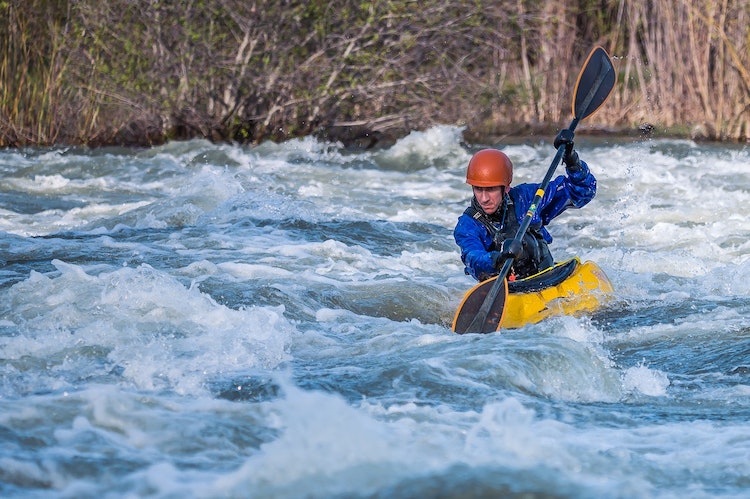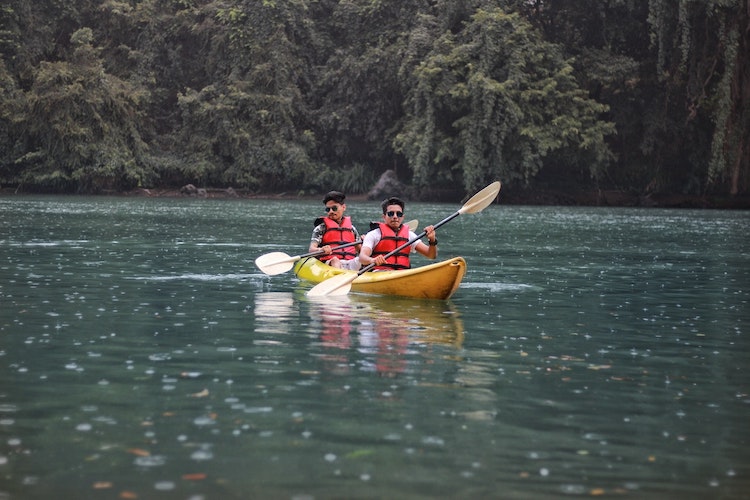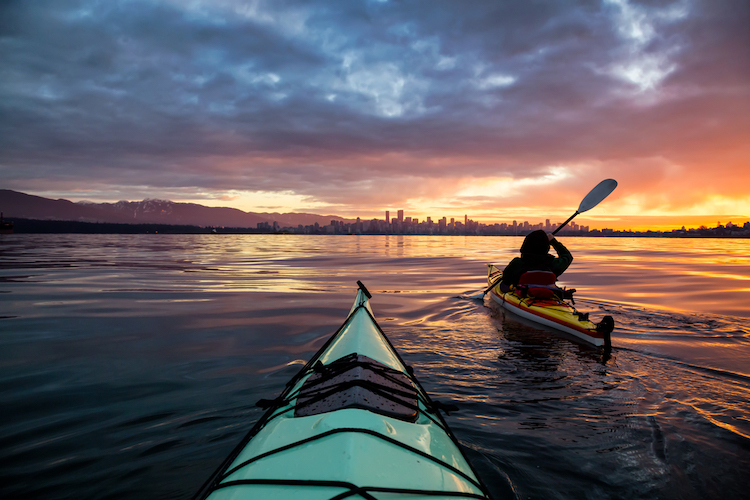As the weather gets warmer, many people dust off their kayaks and get ready for a season of exploration. Kayaking is a great way to explore the outdoors, especially if you are an avid adventurer. It is both relaxing and challenging.
There are many rivers, lakes, and other bodies of water where you can kayak. However, safety is an issue whenever you go out in the wild with your kayak. No matter how experienced you are, there is always something new because it is a sport for newer adventure seekers.
With that said, here are fourteen tips on how to keep yourself safe while kayaking in the water.
Tips for Kayaking Safety
Before we get started on our kayaking safety tips, you should buy a rack to safely transport your kayak to your chosen location. There are racks for any truck & any budget on the market. So, we recommend you look around and find the perfect rack for your vehicle first.
Now, to make it simple for you to follow and remember, our safety tips are divided into three groups –
- Equipment safety tips.
- Weather and environmental safety tips.
- Personal safety tips.

Equipment Safety Tips for Kayakers
To begin with, let us tell you about the safety tips you need to follow when it comes to your kayaking equipment.
1. Inspect Your Kayak Before You Launch It Into the water
First, you must ensure that your kayak is in perfect condition. Before you launch your kayak into the water, it is crucial to inspect it for any damage or potential hazards. Here are some things you need to check –
- Check the hull of your kayak for any cracks, holes, or other damage.
- Ensure all your kayak’s parts (seat, paddles, etc.) are securely attached and in good working condition.
You’ll be confident that your time on the water is enjoyable and safe if everything is fine. And if not, don’t take any risk.
Go back, repair your kayak and come again!
2. Always Wear a Life Jacket / Personal Flotation Device
It doesn’t matter if you’re a swimming champion; you must always wear a life jacket or personal flotation device (PFD) while kayaking. It will keep you afloat if you fall out of your kayak and can help prevent drowning.
There are many different types of PFDs available, so it’s important to choose one that is comfortable and fits appropriately. You should also make sure that your PFD is USCG-approved.
Wearing a PFD is the law in some states, so check the regulations in your area. Even if it’s not required by law, it’s always a good idea to wear a PFD when kayaking.
3. Dress Appropriately for Kayaking Conditions
You should dress for kayaking conditions as you would for any other outdoor activities. That means wearing clothing that will protect you from the sun, wind, and water.
Here are a few specific kayaking dressing tips to keep in mind:
- Dress in layers: Wearing layers of clothing helps you regulate your body temperature and stay comfortable in changing conditions.
- Choose quick-drying fabrics: Fabrics that dry quickly will help you stay more comfortable if you get wet.
- Wear closed-toe shoes: Shoes that cover your feet completely will protect you from scrapes and cuts.
- Protect your skin: In addition to sunscreen, you may want to wear a hat, sunglasses, and long-sleeved clothing to protect your skin from the sun.
- Be prepared for cold weather: If you’ll be kayaking in cold weather, dress in warm, waterproof clothing.
4. Bring a Whistle and a Flashlight
If you’re heading out for a paddle on your own, be sure to bring a whistle and a flashlight. A whistle can attract attention if you need help, and a flashlight can signal for help if you’re out after dark.
Of course, you should always know your limits when kayaking. But a whistle and flashlight can give you an extra sense of security.
5. Never Forget Your Knife
One of the most important safety tips for kayakers is never forgetting your knife. A knife can be used for various purposes while out on the water, including cutting rope, slicing through vegetation, and even self-defense.
Always ensure that your knife is easily accessible and that you know how to use it properly.
Weather and Environmental Safety Tips
Now that you know the things to double-check when it comes to your kayaking equipment, it’s time to learn about all the weather and environmental factors that you must keep in mind.
6. Check the Weather Forecast Before Heading Out on the Water
The weather can change rapidly when you’re out on the water, so it’s important to check the forecast before heading out. If strong winds are predicted, consider postponing your paddle or choosing a different location.
If you’re kayaking, you’ll want to pay attention to the wind speed and direction. If the wind is blowing toward you, it can create waves that make it difficult to paddle. And if the wind is blowing too hard, it can create dangerous conditions.
It’s also important to check the temperature. If it’s going to be cold, make sure you dress appropriately. And if it’s going to be hot, ensure you have enough water to stay hydrated.
7. Look for Safety Signs on Beach and River
As a kayaker, it’s important to be aware of your surroundings and to look for safety signs when you’re out on the water. Here are some tips to help you stay safe while kayaking:
- Look for posted signs on the beach or the riverbank before entering the water. These signs can provide important information about present or potential hazards in the area.
- Be constantly aware of your surroundings and look out for potential hazards, such as rocks, currents, and other kayakers.
- If you see a hazard, avoid it if possible. If you can’t avoid it, paddle around it safely.
8. Learn to Handle Your Kayak in Strong Winds
Windy conditions can create waves and chop, making paddling difficult and dangerous.
Try to launch your kayak from a protected area if possible. This will help you avoid windy conditions and waves. If you find yourself paddling in strong winds, paddle perpendicular to the wind to help stabilize your kayak.
Be aware of waves and chops created by the wind. Avoid paddling through them if possible. Use extra caution when turning your kayak. The wind can push your kayak sideways, making it difficult to control.
9. Don’t Kayak at Nighttime
Many dangers can come from kayaking at night. It can be difficult to see obstacles in the water, which can lead to accidents. It’s also harder to stay aware of your surroundings when it’s dark, so you may not be able to react quickly if something happens.
If you do decide to go kayaking at night, be sure to take some extra safety precautions. Wear bright clothing to be more visible, and bring a flashlight to see where you’re going. It’s also a good idea to go with someone else so you can keep an eye on each other.
10. Be Careful of Wildlife
Alligators are a common sight in many waterways, so it’s important to be aware of alligators and other animals.
Avoid areas where alligators or other dangerous animals are known to congregate. If you see an alligator sunning itself on the shore, it’s best to give that area a wide berth.
If you do meet any wildlife, stay calm and paddle away slowly. Don’t make sudden movements that could startle them and cause them to attack.
Personal Safety Tips for Kayakers

In addition to your equipment and the natural conditions, there are some other things that you need to do to ensure a safe kayaking adventure. They can be called “personal safety” tips and that’s what you’re about to read in this section.
11. Use the Buddy System
Next time you head out for a kayaking adventure, bring a friend or two. It’ll help keep you safe and make your trip more enjoyable.
The buddy system is important because it provides an extra set of eyes and ears while on the water. Having someone with you in an emergency is also a good idea.
If you’re kayaking alone, tell somebody (your parents or best friends) where you are going, so they know where to find you if something goes wrong. They can also check on you periodically to ensure you’re ok!
12. Know Your Limitations
Trying to over-achieve when you’re kayaking in the wild is not a good idea. Don’t push yourself beyond your limits; always paddle within your abilities.
If you’re not comfortable with a certain stretch of river or rapids, portage around them. It’s not worth risking your safety to try something beyond your abilities.
13. Know What to Do If You Capsize or Fall Out of the Kayak
If you capsize or fall out of your kayak, the first thing you should do is stay calm. It may be difficult to do this if you are in the water and cold, but it is important to try to remain calm so that you can think clearly and follow the steps below.
- If you are with someone else, have them call for help.
- If you are alone, try to get to shore as quickly as possible.
- If you can’t get to shore, stay with your kayak. It will provide you with some floatation and protection from the elements.
- If you are unable to get back into your kayak, signal for help. You can do this by waving your arms or using your emergency signal equipment if you have one.
- Once you are back in your kayak, paddle to shore as quickly as possible and get out of the water to warm up and dry off.
Always remember to take other safety precautions when kayaking to help prevent accidents from happening in the first place.
14. Bring Plenty of Food and Water
When you go kayaking, it’s essential to bring plenty of food and water. You never know when you’ll get hungry or thirsty, and it’s better to be safe than sorry.
Pack snacks and drinks that will keep you hydrated and satisfied, and pack more than you think you’ll need. It’s always better to have too much than not enough.
Conclusion
Kayaking in the wilderness sounds like a simple activity anyone could do. However, given how dangerous kayaking can be, these safety precautions must be followed before and during the time you start paddling around.
Water isn’t a place to fool around; it takes less than a minute for a kayak to flip upside down before you even notice! You can injure your partner — or even worse, get yourself hurt.
So, remember these safety tips that could help you get through your next trip to the river. Good luck!
FAQs
1. Is Kayaking Safe for Non-Swimmers?
Yes, kayaking is safe for non-swimmers, as long as you wear a life jacket and stay away from rough waters. However, we strongly suggest you learn swimming before you go into the wild with your kayak.
2. Why Do My Hips Hurt After Kayaking?
Your hips may hurt after kayaking because you are using muscles you are not used to. Kayaking is a low-impact sport, but it still requires some physical exertion. If your hips are hurting, try to take a break and stretch your muscles.
3. Can a Kayak Flip Over?
Yes, a kayak can flip over. If you are not careful, or if the water is rough, your kayak can flip over and fill with water, which can be dangerous.







































































I rented a kayak and was never told how to deal with a following sea. So I flipped it making the 360 degree turn and after having to beach it to get the water out, then had to figure out how to back-paddle in order to not broach. again. Fortunately I had sailed a dinghy years early so I could feel how the wind and following waves were taking control of the stern and could compensate quickly. Not hard to paddle into the wind. Following sea was tough!
These safety tips are essential for anyone going kayaking in the wild. I especially appreciate the advice on inspecting your kayak before launching it into the water. It’s crucial to ensure that everything is in good working condition and that there are no potential hazards. I also like the reminder always to wear a PFD and dress appropriately for the conditions. It’s better to be prepared than to find yourself in a dangerous situation. Thanks for sharing these tips!
Small advice: go with specifically water shoes(flexible zero drop shoes that get dry extremely fast. I guess just google those or something, I’ve got my pair from Run United at one point, been using those for 2 years or something by now) – Those both protect you from cuts AND allows you foot to move well in water without dragging you down. Also great for when you’re not kayaking in case you gotta climb stones n stuff.